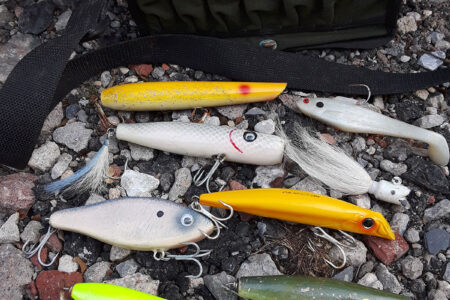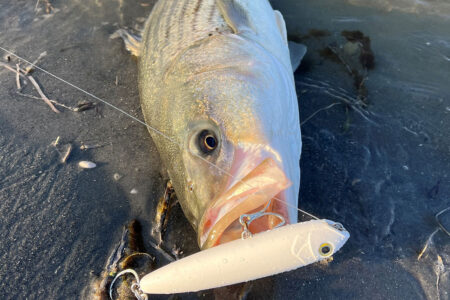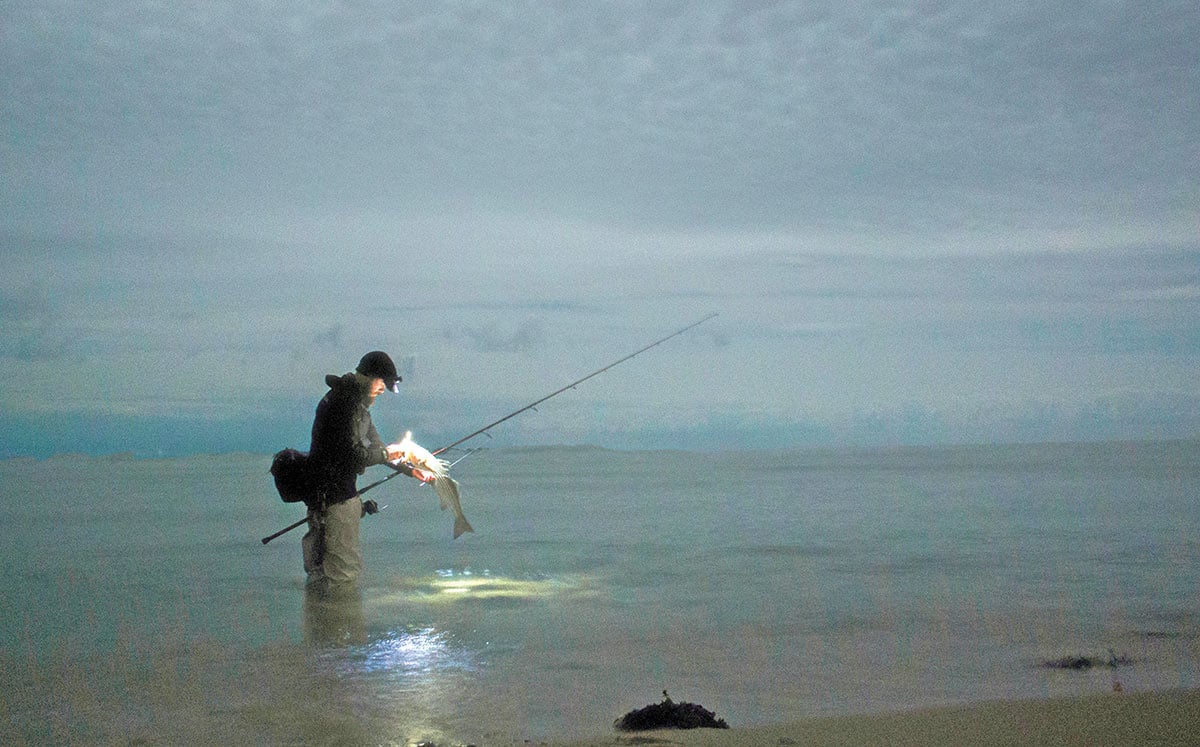
When finicky stripers feed on sand eels in the surf, it’s the little things that make all the difference.
There’s nothing quite like fishing an angry, raging surf. I enjoy slinging bucktails into a good heave, especially on beaches filled with sand eels in the late fall. The fish are often aggressive, and if I find them, it can be lights-out action.
However, where I fish in New England, this is a rare situation. Just as often there is only small wave action—or none at all. Worse, this often means the water is extremely clear, and it makes for difficult fishing. In fact, there are few conditions that are more challenging than an open beach during calm and clear conditions. But, as the season wanes, staying home isn’t an option; getting those few final fish before winter is important! If you’ve found fish there recently, and sand eels are thick, I can almost assure you there are striped bass in the area even if it’s calm and clear. Your challenge is to catch them. This can be rewarding; there’s nothing quite like “figuring out” a tough bite, and it can feel as good as catching your personal best.
For example, one memorable night recently, I snuck into a spot that was being fished by four other fishermen. While I had had some decent catches recently, it was dead calm and the bright, full moon was casting shadows. I took a moment to watch the other fishermen; they weren’t into fish. They were all fishing the same plug, and didn’t seem to be doing anything other than casting it out and using a straight retrieve. I could see sand eels in the gin-clear water, and thought I saw a swirl of a predator. I crept down to the shore, began to cast, and I immediately was into fish. The fishermen around me all went fishless for an hour before they gave up and started to leave. It wasn’t until they walked almost right up to me that they noticed I was there. Unfortunately, I was into a decent teen-bass as they got closer, and they surrounded me and began to fish. However, after another 20 minutes, they still were fishless and I had landed another half a dozen fish. I don’t know what they were thinking exactly, but they all decided to leave, which was fine by me! I continued to catch for an hour after they left, and had a blast with fish of all sizes maxing out around 15 pounds.
What was the difference between what I was doing and what they were trying to do? It may have been subtle, but I have some suggestions of how to capitalize on this situation, as I did in the above story.
Prepare Yourself to Fish
First and foremost, you have to get into a proper mindset for these extremely calm situations. You have to be focused and paying attention to as many details as you can. This is because the difference between catching double-digits and getting “skunked” can be razor thin. Upon hitting the beach I like to take a moment before making any casts to pause and study the water. The smallest wave, patch of nervous water or a small swirl could be critical in your success. So really commit and study the water for a few minutes before you start to fish.
Along these same lines, I like to be as quiet and stealthy as possible. This means I don’t enter the water until I’m positive I have to, and only wade as far as is absolutely necessary. In many situations, I won’t ever get my boots wet. I am always surprised how tightly the bass—even moderately-sized ones—will hold to shore in these situations, and by stomping into the surf and shuffling my feet I have spooked more than a few bass I didn’t even realize were there.
It goes without saying fishing at night is a necessity, but part of this is also to sparingly use a light, or getting a very dim red light. As a serious surf fisherman, you should be using a red light anyways, as it preserves your night vision and doesn’t spook fish in all situations. However, I won’t use my light at all—not even the red light—unless I have to re-tie my leader for some reason, which is extremely rare in this situation. Having an organized plug bag, and practicing putting the plugs on a snap/snap swivel with your eyes closed, is important, and if you practice enough, you shouldn’t ever have to turn on a light. I have personally had two bites this season alone ruined by other anglers shinning their lights on the water; not only do you not want to be “that guy” but you will catch significantly less.
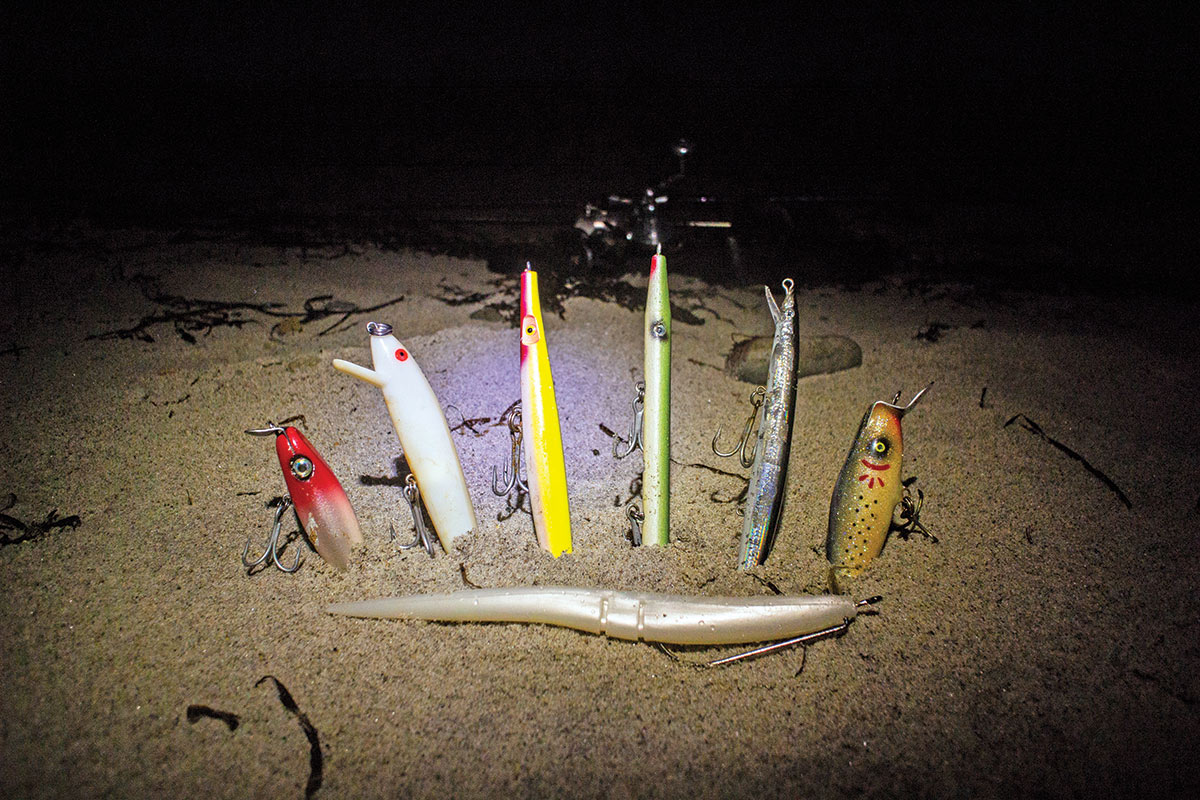
It’s All About the Bottom
Now that you’re prepared to fish, the next most important thing in this situation is that you have a good grasp of what the bottom contour looks like. I like to fish whatever the lowest spot is on a particular stretch of beach. Even in a long trough, I look for the absolute bottom where bass wait in ambush. In the extremely clean and clear water, the bass want to be on the bottom. Well, that is to say, they want to be on the bottom most of the time. Bass also follow the sand eels, and I have found them up on flats that are less than 2 feet deep, so don’t overlook these. In fact, anything that looks “different” deserves a cast in these situations; “different” usually means an edge, which usually means it’s an ambush point for the bass. To find these spot-within-spots I have to scout at low tide, sometimes several times a year as they can change with fall storms. Do your homework, and you will be rewarded.
More Than a Straight Retrieve
In many situations plug selection takes a back seat to presentation, and this has never been truer than imitating sand eels in calm conditions. I am obsessed with varying my retrieve and will try everything in the book—slow, fast, erratic, straight, random, dead-stick, etc.—until I lock in on what they want that particular night. If I had to pick just one retrieve it would be an extremely slow roll, with small hard twitches. This works for virtually any plug, and if you’ve ever observed sand eels, it’s probably not surprising why: this is often how they act, sitting very still, and then darting away. It takes patience, but I have found this to be vital. It might take a few fish to figure it out, but once I do, I include it in my fishing log, along with my catch stats so that I remember for next tide or next year.
Along these lines of plug presentation, I also rarely fish anything that makes a lot of noise. I shy away from plugs that rattle, vibrate intensely or splash a lot. Vibration is critical to striped bass hunting, and they are sensitive to it. In these calm situations, I imagine many plugs that have loud rattles sound like a jack-hammer under the water. Sure, in situations with crashing waves, it works great to attract attention, but under calm conditions it also isn’t natural. I want a plug that peaks a bass’s interest, but it still has to look for it; I want it to blend into the background. For this reason, I would like to make special mention of the 7-inch unloaded Red Fin. I know it casts terribly, but when it’s calm and you aren’t fighting wind, an unloaded Red Fin will stay right on or under the surface under a variety of retrieves. It doesn’t have any rattle, and the action during a slow retrieve is subtle; the fish seem to find it irresistible. It’s one of the first plugs I reach for.
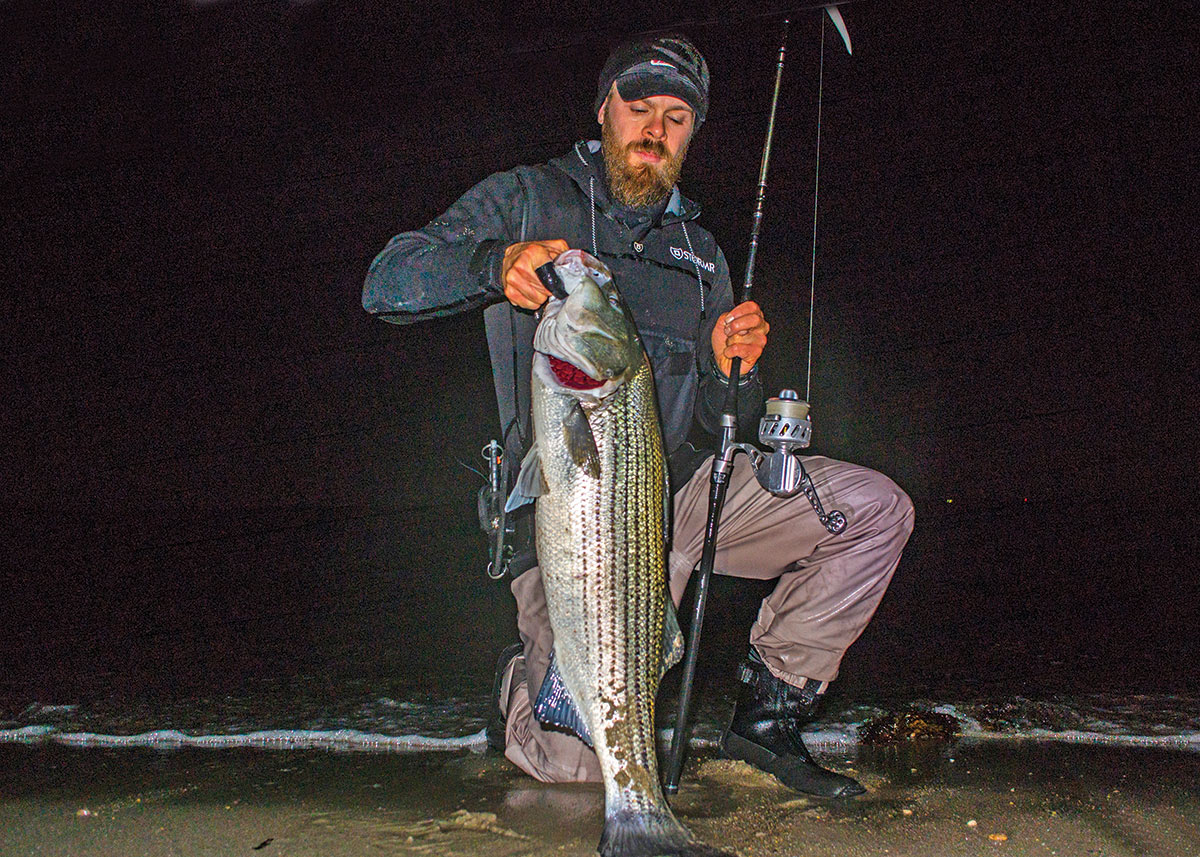
The Gear
To cast a light plug like the unloaded Red Fin, and also be able to handle 20-pound-or-better fish, you need semi-specific tackle. I fish a much lighter line and rod than I would normally. I mostly rely on a light-action 9-footer capable of throwing about 2.5 ounces. This is one of the only times I use a separate spool for my Van Staal VSX200 that has 20-pound braid on it. Don’t skimp on braid when going this light; quality becomes even more important as it’s easy to get tangles and wind knots. I usually use a fairly light 20- or 30-pound mono leader. I’m not worried about the fish seeing the leader; I’m an ardent believer that striped bass are not leader shy no matter the conditions. However, it helps the subtle action of light plugs if you have a lighter, soft leader, which is why I do it. But don’t go too light! I’ve set the hook on a fish before that took off immediately and exploded my 20-pound leader knot like it was dental floss.
For plugs, I rely on a small handful of regulars; I worry more about presentation than stuffing my plug bag. As mentioned previously, I like loaded and unloaded 7-inch Red Fins. They are good compromises of size and subtle action. I also love 7- and 9-inch Lunker City Slug-Gos fished with a weightless swim bait hook. Small, thin needles can be very effective, but some are hard to work slowly enough in shallow, calm waters. A less widely appreciated plug is the small metal lip, and I have a few I really like. I often look over freshwater selections from well-known plug builders. I refer to them as my “secret weapons” because, despite not really matching the bait profile, fussy fish are often hard-pressed to pass them up for some reason. Further, most rattle-less swimmers (like some Bombers) work well. And if you don’t fly fish, this is a great bite to learn on; a 10-weight with floating or intermediate line, a 6-foot section of 20-pound monofilament, and a handful of thin deceiver flies are all you need—it can be an absolute blast!


